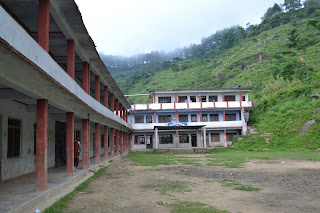Although the small plot of corn behind our apartment in the
city is nice and the constant car, truck, and bicycle horns keep you on your
toes while walking down the street, Gorkha was a pleasant reprieve after the
hectic, dusty making-it-hard-to-breathe-but-muddy-enough-to-make-your-shoes-get-stuck
atmosphere of Kathmandu. The other ETAs and I spent the week visiting potential
schools and homestay families and in an a
ttempt to avoid giving a running
play-by-play of every magical moment, I’ve compiled a list of this week’s
highlights (which may or may be a direct result of watching SportCenter’s Top
10 growing up…)
1. Laundry rules still apply –i.e. always separate
your whites from your colors. Especially when bucket washing a new red kurta
for the first time. But then again, maybe you prefer a new slightly pink
wardrobe like me…
We’ve also turned our apartment
common room into a temporary laundromat as it’s proven challenging to dry
clothes during monsoon season here in Kathmandu. It seems as though the skies
open up just as we leave the office
for the day, soaking our dry laundry by the time we get back to the apartment. It
gives the “fresh rain” detergent scent a whole new meaning.
2. While I have always managed to get by in Zumba
classes (meaning I usually end up in
the same direction as everyone else without stepping on any toes or hitting
someone with my flailing arms), I’m going to need a bit more practice to master
the hip and hand coordination for Bollywood dancing. A few of us tried our luck
in a dance class last weekend and had a blast, although I don’t think we’ll be
scouted for any Bollywood music videos any time soon.
3. Nepal
has both hills and mountains and the Nepalese are quick to mark the difference
between the two. It’s not just the words (here’s where I’ll shamelessly show
off my Nepali –“Daadaa” means “hill,” “pahahd” is mountain, while “himal”
refers to a snow-covered mountain…yep, just like the Himalayas). We’ve done
some “beginner trekking” to visit Buddhist temples and am always amazed by how
Nepali worshippers aren’t dripping with sweat like we are by the time they get
there!. How are these only considered hills? But rounding the bend on our way
into Gorkha, we caught a teeny tiny
glimpse of the Himalayas in the distance. Ok, these are the mountains I’ve read
about. They are absolutely stunning. While the Himalayas remain mostly hidden
behind clouds during monsoon season, we’ve been promised an incredible view when
the skies clear in a few months. “They’re like the trailer for a movie,” our
guide told us. “You’ll have to come back to see the whole show.”



4. I’ve been reminded over and over that you’re
never too old for playground games. Christine Stone has continued with her
classroom preparation training and we spend hours coloring, cutting, gluing,
hand-clapping, foot-stomping, and chanting as we put together our “teacher’s
toolbox.” I can only imagine what it must look like to passerbys who may witness
a group of 20-something-year olds being chased around the office parking lot by
an elderly British woman and her barking dog as she demonstrates how to play
“What time is it Mr. Fox?”
Despite the warnings we’ve received of how
the next seven months will be challenging, I’m excited to finally get in the
classroom and start teaching!
5. Adjusting to life in a new country is like
learning how to juggle (and thanks to our fellow ETA and juggling teacher,
Peter, we’re attempting to do that as well!) The past two weeks have been
exhilarating, yet exhausting as I attempt to balance Nepali language practice,
preparing lesson plans and supplies, bonding with my fellow ETAs and making
time for personal reflection. It’s learning give and take. Toss. Toss. Toss.
Catch. Catch. Catch.
 |
| Rachel and Jeanie learning how to juggle! |
6.
Caste hierarchy is still prevalent and is used
as a way of arranging parts of Nepali society, directly affecting the education
system we will be working in. Members of higher castes have the economic
ability to send their children to “boarding,” or private schools, where English
language training begins earlier than in the governmental public schools.
Dalits, on the other hand, are economically disadvantaged and therefore can
only afford to send their children (or often times only the boys) to
governmental schools
7.
If someone asks if you’re married and you
respond “no- mero bihah bhayako chaina,” more often than not, they will
immediately try and set you up with a son, brother, nephew or grandson, keeping
with the tradition of arranged marriages. I’ve already gotten an offer…
The idea of a ‘love marriage’ is still a
relatively new concept, although is growing in popularity with the younger
generations, especially in the more developed, urban areas.
8.
“Chiyya chuTTi” is my new favorite phrase to
hear. It translates to “tea break” and I have yet to be disappointed with the
delicious Nepali milk tea! Chiyya chuTTi can happen at any point in the day and
is commonly used as a show of hospitality. I lost count of the number of cups
of tea I drank while visiting home stay placements!
9.
Traffic will teach you patience. On our way home
from Gorkha, we got to experience our first “road widening” traffic jam. The
narrow road that serves as the only route out of the city and into the hills is
under construction to provide more space for the trucks that constantly break
down. You learn to sit back, relax, practice Nepali and gaze out the window to
see…an elephant?
10. Having
some extra toilet paper with you always comes in handy. Enough said.
More photos are up on facebook, but here are some personal favorites:
 |
| Prayer flags at Swayambhuanth |
 |
| Stupa at Bhouda |
 |
| Traditional dhaal baat meal |
 |
| Welcome to Gorkha! |





























